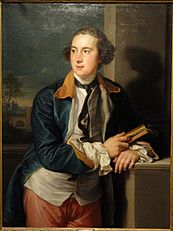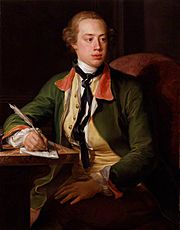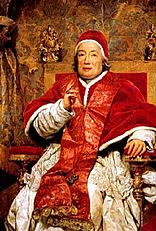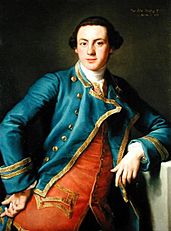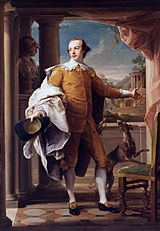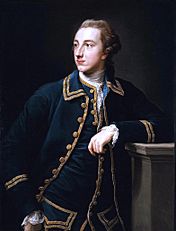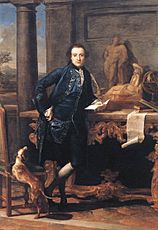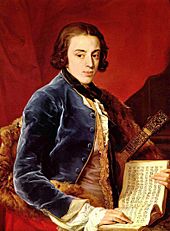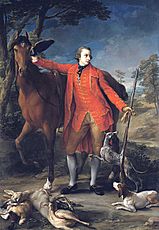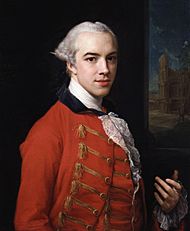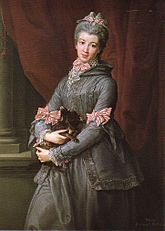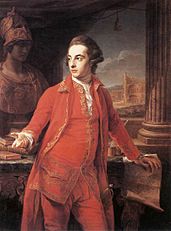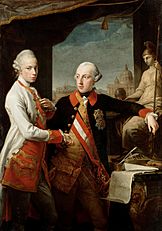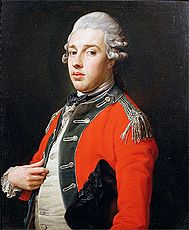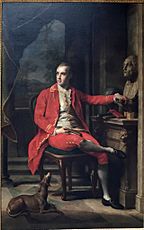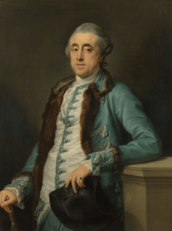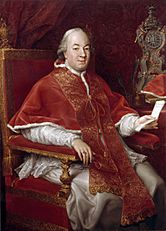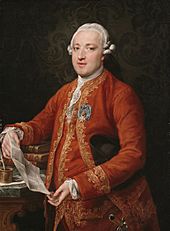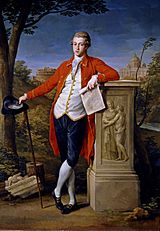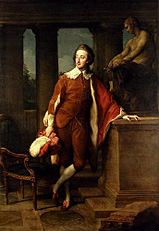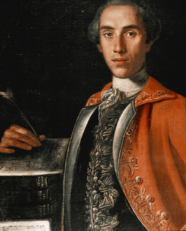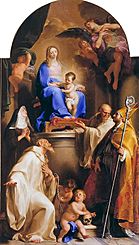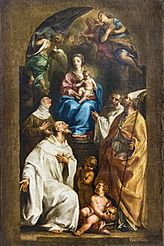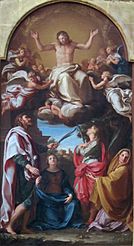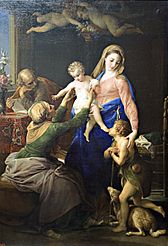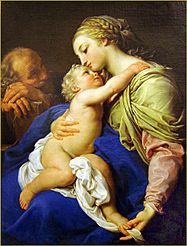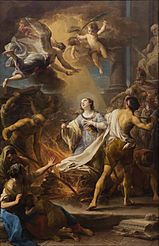Pompeo Batoni facts for kids
Quick facts for kids
Pompeo Batoni
|
|
|---|---|

|
|
| Born | 25 January 1708 |
| Died | 4 February 1787 (aged 79) |
| Nationality | Italian |
| Education | Agostino Masucci, Sebastiano Conca |
| Known for | painter |
| Spouse(s) | Caterina Setti, Lucia Fattori |
Pompeo Girolamo Batoni (born January 25, 1708 – died February 4, 1787) was a famous Italian painter. He was very skilled at painting portraits. He also created many pictures about myths and stories.
Many visitors from other countries came to Italy, especially Rome, on their "Grand Tour". This was a trip that young noble people took to learn about art and culture. Batoni became very good at painting their portraits.
He became famous around the world because of these customers. Most of them were British nobles. He often painted them with beautiful Italian landscapes in the background. These "Grand Tour" portraits were very popular in Great Britain. Later, another famous painter, Sir Joshua Reynolds, continued this style. Batoni was seen as the best Italian painter of his time.
Besides nobles, Batoni painted kings and queens from Poland, Portugal, and Prussia. He also painted Holy Roman Emperors Joseph II and Leopold II. This even earned him a noble title! He also painted popes like Benedict XIV, Clement XIII, and Pius VI. Batoni also created many altarpieces for churches in Italy. He painted many mythological and allegorical scenes too.
Batoni's painting style was inspired by ancient Roman and Greek art. He also used ideas from French Rococo art and Bolognese classicism. He admired artists like Nicolas Poussin, Claude Lorrain, and especially Raphael. Because of this, Pompeo Batoni is seen as an early artist of the Neoclassicism art movement.
Contents
Pompeo Batoni's Life Story
Early Life and Training
Pompeo Batoni was born in Lucca, Italy. His father, Paolino Batoni, was a goldsmith. Pompeo was baptized on February 5, 1708.
In 1727, he moved to Rome. There, he learned painting from famous artists like Agostino Masucci and Sebastiano Conca.
Becoming a Famous Painter
Batoni got his first big painting job in 1732. He was drawing old carvings and paintings at a palace in Rome. A nobleman named Forte Gabrielli di Gubbio saw his amazing skill.
Gabrielli asked Batoni to paint a new altarpiece for his family's chapel. This painting was called Madonna on a Throne with Child and four Saints and Blesseds of the Gabrielli family. It was finished in 1733. Everyone admired this painting.
By the early 1740s, Batoni started getting many more important jobs. His famous painting, The Ecstasy of Saint Catherine of Siena (1743), shows his refined style. Another great work, Fall of Simon Magus, was first painted for St Peter's Basilica.
Batoni became a very popular painter in Rome. This was especially true after his rival, Anton Raphael Mengs, moved to Spain in 1761. Batoni was friends with Johann Joachim Winckelmann, a famous art historian. Like Winckelmann, Batoni wanted his paintings to show the calm, classic style of older masters like Raphael and Poussin.
In 1741, he became a member of the Accademia di San Luca, a famous art academy.
He was in high demand for portraits. Many British travelers on their Grand Tour wanted him to paint them. He often showed them standing among ancient ruins or famous artworks. Records show he painted over 200 portraits of British visitors.
These "Grand Tour" portraits by Batoni became very common in British homes. This made the style popular in the United Kingdom. There, Sir Joshua Reynolds became the leading painter of such portraits. In 1760, the painter Benjamin West said that Italian artists only talked about and looked at Batoni's works.
In 1769, Batoni painted a double portrait of Emperor Joseph II and his brother Pietro Leopoldo I. This painting earned Batoni a noble title in Austria. He also painted Pope Clement XIII and Pope Pius VI.
It is said that before he died, Batoni gave his painting tools to Jacques-Louis David. He admired David's painting, Oath of the Horatii, very much.
Later Years and Family Life
In his later years, Batoni's health declined. He died in Rome in 1787 at age 79. He was buried in his church, San Lorenzo in Lucina.
From 1759, Batoni lived in a large house in Rome. It had a studio, exhibition rooms, and an art academy. He was married twice. First, to Caterina Setti in 1729, who died in 1742. Then, in 1747, he married Lucia Fattori. They had twelve children. Three of his sons helped him in his studio. His daughters Rufina and Maria Benedetta were talented singers.
Batoni's Influence on Other Artists
Many artists learned from Pompeo Batoni or were inspired by his work. Some of his students included Vincenzo Camuccini, Angelo Banchero, Benigno Bossi, and Antonio Cavallucci.
Among foreign artists, Henry Benbridge from Philadelphia, Maria Cosway from Florence, and Ivan Martos from Poltava were influenced by Batoni.
Art Critics and Exhibitions
Pompeo Batoni was one of the most celebrated Italian painters of his time. Kings, queens, and nobles from all over Europe bought his art. However, his fame faded in the 1800s.
In the 1900s, art experts started studying his work again. They helped bring his fame back to the public. Some of these experts were Ernst Emmerling, John Steegman, and Anthony M. Clark.
The first art show just for Pompeo Batoni's works was in his hometown of Lucca in 1967. Later, two more shows were held in London and New York in 1982. He was also the main subject of a big exhibition in Houston, London, and Lucca in 2007-08.
A portrait of George Oakley Aldrich was found in the Bodleian Library in Oxford. Art experts believe it was painted by Batoni. This discovery was featured on a TV show called Britain's Lost Masterpieces. After being cleaned, experts confirmed it was indeed a Batoni painting.
Famous Works by Pompeo Batoni
Allegory and History Paintings
- The Virgin Mary enthroned with saints of the Gabrielli di Gubbio family — (1732–33), San Gregorio al Celio, Rome
- The five allegories of the Arts — (1740) Stadelsches Kunstinstitut, Frankfurt am Main
- Apollo and Two Muses - (1741) Museum of King John III's Palace at Wilanów, Warsaw
- Catherine of Siena in Ecstasy — (1743) Museo di villa Guinigi, Lucca
- Achilles and Lycomedes — (1745) Uffizi, Florence
- Time orders Old Age to destroy Beauty — (1746) National Gallery, London
- Fall of Simon Magus — (1746–1755) St Peter's Basilica, Rome
- Aeneas escaping from Troy — (1750) Sabauda Gallery, Turin
- Vulcan - (1750) National Gallery of Canada, Ottawa
- Cleopatra shows Octavian the bust of Caesar - (1755) Musée des Beaux-Arts de Dijon
- Martyrdom of Saint Lucia — (1759) Real Academia de Bellas Artes de San Fernando, Madrid
- The Holy Family — (1760) Capitoline Museum, Rome
- Diana and Cupid — (1761) Metropolitan Museum of Art, New York
- Madonna — Church of Santa Maria in Monterone, Rome
Portraits
- Portrait of Giacinta Orsini— (1758)
- Portrait of a Man in a Blue Suit — (1760s) Dallas Museum of Art
- Portrait of Richard Milles — (1760-1770) National Gallery, London
- Portrait of Humphry Morice — (1761) National Gallery, London
- Portrait of Charles Crowle — (1761–1762) Louvre, Paris
- Portrait of Lord Dundas — (1764) Aske Hall, Yorkshire, England
- Portrait of Manuel de Rodas — (1765) Real Academia de Bellas Artes de San Fernando, Madrid
- Portrait of Abbondio Rezzonico — (1766) Galleria Nazionale d'Arte Antica, Rome
- Portrait of Sir Gregory Page Turner — (1768) Private Collection
- Portrait of Leopold, Grand Duke of Tuscany — (1768) Private Collection
- Portrait of Thomas Estcourt, Esquire — (1772) John Hay Library, Brown University
- Selfportrait — (1773–1774) Uffizi, Florence
- Portrait of Thomas William Coke — (1774) Holkham Hall, Norfolk, England
- Portrait of a Man (John Scott?) — (1770) National Gallery, London
- Portrait of Pius VI — (1775–1776) Sabauda Gallery, Turin
- Portrait of Douglas, 8th Duke of Hamilton — (1775–1776) Inveraray Castle
- Portrait of Francis Basset — (1778) Real Academia de Bellas Artes de San Fernando, Madrid
- Portrait of Francis Basset 1st Baron of Dunstanville — (1778) Prado Museum, Madrid
- Portrait of George Legge Viscount Lewisham — (1778) Prado Museum, Madrid
- Portrait of Pope Pius VI — (ca.1780) Royal Castle, Warsaw
- Portrait of Pierre André de Suffren — (c.1785)
- Portrait of the Countess Maria Benedetta di San Martino — (1785) Thyssen-Bornemisza Museum, Madrid
Images for kids
-
John Talbot, later 1st Earl Talbot, 1773. J. Paul Getty Museum, Los Angeles
-
William Fermor, 1758. Museum of Fine Arts, Houston
-
Portrait of Maria Anna of Austria, Queen of Portugal
-
Portrait of John V, King of Portugal, aged about 17. Palace of Ajuda, Lisbon.
Gallery
Portraits
-
Cardinal Prospero Colonna di Sciarra, c.1750, Walters Art Museum, Mount Vernon, Baltimore
-
William Legge, 2nd Earl of Dartmouth, 1752–56, Hood Museum of Art, Dartmouth College
-
John Rolle Walter, c.1753, Royal Albert Memorial Museum, Exeter
-
Clement XIII, 1758, Museo Nazionale del Palazzo di Venezia, Rome
-
Portrait of Richard Milles, 1758, the National Gallery, London
-
John Armytage, 2nd Baronet, 1758, private collection
-
Sir Wyndham Knatchbull-Wyndham, 6th Bt, 1758–59, Los Angeles County Museum of Art
-
Portrait of Humphry Morice, c.1762, National Portrait Gallery, London
-
Cardinal Jean-François-Joseph de Rochechouart, 1762, Saint Louis Art Museum, Saint Louis,
-
Luigi Boccherini, c. 1764-67, National Gallery of Victoria, Melbourne
-
Manuel de Roda, c.1765, Real Academia de Bellas Artes de San Fernando, Madrid
-
General William Gordon, 1765–66, Fyvie Castle, Fyvie, Aberdeenshire
-
Philip Metcalfe, 1766–67, National Portrait Gallery, London
-
William Cavendish, 5th Duke of Devonshire, 1768, Chatsworth House, Derbyshire
-
Sir Gregory Page-Turner, 3rd Baronet, c.1768, private collection
-
Thomas Estcourt, Esquire,1772, John Hay Library, Brown University
-
Portrait of a Man, 1774, National Portrait Gallery, London
-
Reverend Thomas Kerrich, c.1774, previously at Geldeston Hall, Norfolk
-
Pope Pius VI, 1775, Palazzo Braschi, Rome
-
Francis Basset on the Grand Tour in Rome, 1778, Prado Museum
-
Anthony Ashley-Cooper, 5th Earl of Shaftesbury, 1782, St Giles House, Wimborne St Giles, Dorset
-
Leonardo Leo, 18th century, Conservatorio di musica san pietro a majella
Other Subjects
-
Madonna enthroned with Child and Saints of the Gabrielli di Gubbio family, 1732, San Gregorio Magno al Celio, Rome
-
Madonna enthroned with Child and Saints of the Gabrielli di Gubbio family, 1736, Gallerie dell'Accademia, Venice
-
Christ with Saints Julian and Basilissa, Celsus and Marcionilla, 1736-8, J. Paul Getty Museum, Los Angeles
-
Sacred Heart of Jesus, 1767, Church of the Gesù, Rome
-
Samson and Delilah, 1766, Detroit Institute of Arts, Detroit
-
The Holy Family with St Elizabeth and the Infant St John the Baptist, 1777, Hermitage Museum, St Petersburg
-
Martyrdom of Saint Lucía, 1759, Real Academia de Bellas Artes de San Fernando, Madrid
-
Diana and Cupid, 1761, Metropolitan Museum of Art, New York
See also
 In Spanish: Pompeo Batoni para niños
In Spanish: Pompeo Batoni para niños









